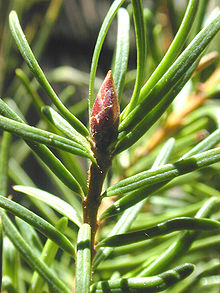Pinidae
| Pinidae | |
|---|---|

| |
| Scientific classification | |
| Kingdom: | |
| Class: | |
| Subclass: | Pinidae Cronquist, Takht. & Zimmerm. 1966
|
| Orders and families | |
| |
Pinidae is a subclass of Equisetopsida in the sense used by Mark W. Chase and James L. Reveal in their 2009 article "A phylogenetic classification of the land plants to accompany APG III."[1] This subclass comprises the conifers. The Pinidae subclass is equivalent to the division Pinophyta and class Pinopsida of previous treatments. There are over 600 species of Pinidae all over the world.
Phylogeny[]
The following diagram shows a likely phylogenic relationship between subclass Pinidae and the other Equisetopsida subclasses.[2]
|
bryophytes
lycopodiophytes
monilophytes
gymnosperms
angiosperms |
Distribution[]
Species belonging to the subclass Pinidae are confined to the Northern Hemisphere. Most Pinidae can be found in the Scandinavian Peninsula, Russia, Alaska, and certain areas in Japan.
References[]
- ^ Mark W. Chase & James L. Reveal (2009). "A phylogenetic classification of the land plants to accompany APG III". Botanical Journal of the Linnean Society. 161 (2): 122–127. doi:10.1111/j.1095-8339.2009.01002.x.
- ^ Maarten J. M. Christenhusz; James L. Reveal; Aljos Farjon; Martin F. Gardner; Robert R. Mill; Mark W. Chase (2011). "A new classification and linear sequence of extant gymnosperms" (PDF). Phytotaxa. 19: 55–70. doi:10.11646/phytotaxa.19.1.3.
- Pinidae
- Gymnosperms
- Plant subclasses
- Equisetopsida sensu lato
- Conifer stubs